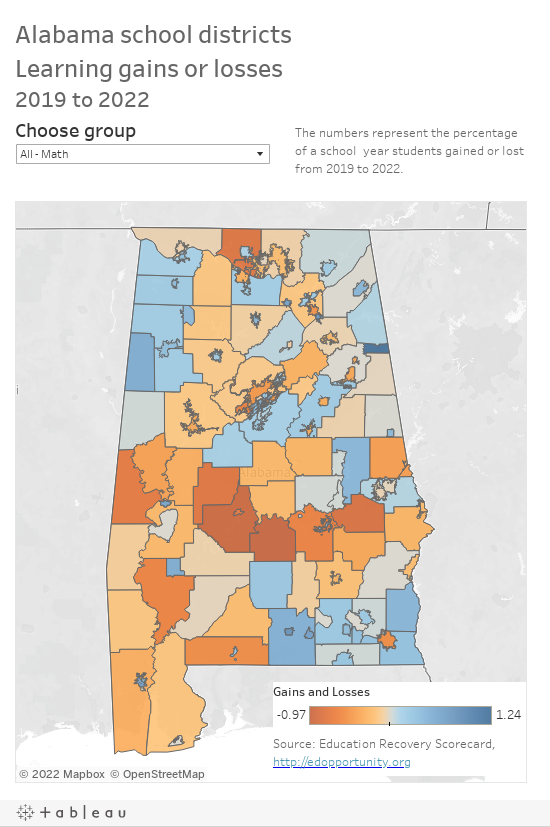Alabama schools lead U.S. in gains for Black, Hispanic students
Want more state education news? Sign up for The Alabama Education Lab’s free, weekly newsletter, Ed Chat.
Black and Hispanic students in Alabama school districts made some of the greatest learning gains during the pandemic, according to a national analysis released last week.
On Friday, an analysis of state test results from 29 states and D.C. showed Alabama school districts made some of the highest gains in math and reading from 2019 to 2022.
That analysis, the Education Recovery Scorecard, dove into how the pandemic impacted learning loss among Black and Hispanic students. Again, Alabama’s students are among those impacted the least – though Black students in some districts lost more than a year of learning, and Alabama’s overall achievement scores remain low compared to other states.
In other words, it is possible for a district to show strong learning gains and still have students learning below grade level in comparison to the average U.S. student.
At the state level, Alabama showed the second-highest reading score gains for Hispanic students–equivalent to about three months of learning–and, while no state increased math scores, Alabama had the least amount of learning loss in math, equivalent to a few weeks.
Among Black students, Alabama had the second lowest learning loss in reading–equal to about a month’s loss of learning. In math, Black students in Alabama had the fourth-lowest amount of learning loss, equal to a quarter of a year in lost learning.
Read more: See how your Alabama school system stacked up nationally on learning gains
Most states showed more than a half a year’s learning loss in reading and math for Black students.
Alabama led the nation for learning gains in reading for white students, equal to a week or so and a loss of a week or so – the smallest loss of all states – in math.
Black and Hispanic students in Alabama school districts
Among Black students’ reading scores, seven of the top 10 performing school districts were in Alabama, with Butler County students showing nearly a year’s worth of learning gains.
Pike Road, Roanoke, Demopolis, Eufaula, Thomasville and Pelham also showed between four and seven months of gains. Three districts in Louisiana were also included in the top 10.
In math, eight of the top 10 highest learning gains for Black students in math were among Alabama districts, with Demopolis City at the top of the list. Pike Road, Ozark, Henry County, Thomasville, Enterprise, Pelham and Hoover also made the list along with two districts in Tennessee.
“This has been a hard season. And it’s exciting to see that their efforts are paying off,” Hoover’s Chris Robbins said of efforts from parents, teachers and students. “Our students have worked hard, our families have worked hard. And they deserve a pat on the back.”
Alabama grabbed all spots in the top 10 gains in reading for Hispanic students, with three – Oxford, DeKalb County and Hoover –showing more than a year’s worth of gains for that demographic group. No Alabama district showed reading learning loss for Hispanic students.
Read more Ed Lab: Alabama isn’t last in the nation for education anymore. What changed?
Learn more about AL.com’s Education Lab team and support our work financially.
Those gains stood in stark contrast to losses in districts in northern states, including districts in Michigan, Massachusetts and Minnesota–which all showed more than a year’s learning loss in reading.
Alabama districts showed the top nine highest gains in math scores for Hispanic students, with Boaz showing the strongest gains nationally at more than half a year’s learning. The majority of Alabama districts where Hispanic students were tested showed gains in math, but two showed a third of year of lost learning in math.
The Education Recovery Scorecard has every combination of subject and student group displayed on a map and in a chart as part of the national analysis and shared the data on their website.
Alabama Education Lab downloaded the data and took a deeper look at the wide range of learning outcomes for students across the state.
The map below (click here if you are unable to see it) displays the variation of gains and losses for each student group in reading and in math. Use the drop down menu to choose a student group.
Still below grade level for most districts and groups
Alabama’s learning gains were impressive, particularly given how few states and districts showed any gains, but even with those gains, achievement levels of most of Alabama’s students are below grade-level when compared with the nation as a whole.
Researchers not only looked at the change in learning from 2019 to 2022, but also isolated the 2022 results to determine at what grade level those results showed that students achieved.
Looking at district-level results, grade levels range widely for students.
Within Alabama, using the grade-level measure, Black students’ math results ranged from just more than half a grade level below the U.S. average in Hoover schools to more than four grade levels below in Sumter, Greene and Bullock counties.
In 11 school districts, Hispanic students’ achievement showed they were reading at two or more grade levels below the average U.S. student. And in two–Montgomery and Birmingham–reading levels of Hispanic students were more than three grade levels below the U.S. average.
White students 2022 scores in reading were below grade level in 60 Alabama school districts. In math, white students performed below grade level in 71 school districts and in two of those–Dallas County and Eufaula City–white students performed more than two grade levels below.
The map below (click here if you are unable to see it) displays the equivalent grade levels compared to the U.S. average public school student in reading and in math. Use the drop down menu to choose a subject and student group.
